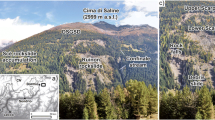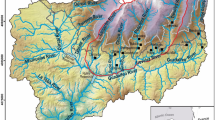Abstract
Early Warning Systems (EWS) are efficient tools for preventing and mitigating the risks associated to landslides occurrence. In this paper, an integrated methodology for landslides’ analysis is presented and described. Such methodology is aimed at the creation of early warning systems and is based on the integration between a modern monitoring technique, such as the Ground-Based Interferometric Synthetic Aperture Radar (GBInSAR), along with advanced numerical modelling. The paper also shows the application of the proposed methodology to the case study of a rockslide in central Italy. The integration between monitoring data, thanks to a GBInSAR survey and advanced numerical simulations with the combined Finite-Discrete Elements Method (FDEM), allowed for the definition of a set of surface velocity thresholds to be adopted for the long-term monitoring of the landslide and for the creation of an effective EWS.










Similar content being viewed by others
References
Abellán A, Jaboyedoff M, Oppikofer T, Vilaplana JM (2009) Detection of millimetric deformation using a terrestrial laser scanner: experiment and application to a rockfall event. Nat Hazards Earth Syst Sci 9:365–372
Scuola di Alta Specializzazione e Centro Studi per la Manutenzione e la Conservazione dei Centri Storici in Territori Instabili (2006) Studio del Fenomeno Franoso in essere in località Tor Giovannetto di Assisi (PG) ed individuazione degli interventi volti alla riduzione del rischio idrogeologico - Relazione Finale ed Integrazioni Alla Relazione Finale. Unpublished report. In Italian
Antolini F (2014) The use of radar interferometry and finite-discrete modelling for the analysis of rock landslides. PhD Thesis, Politecnico di Torino, 273 pp
Antolini F, Barla M, (2014) Combining finite-discrete numerical modelling and radar interferometry for rock landslide early warning systems. Proceedings of XII IAEG Congress, Torino, 15-19 September 2014, Vol. 6 Applied Geology for Major Engineering Projects, 705-708
Aresys 2007 GRAPeS software for IBIS-L, v. 2.7
Atzeni C, Barla M, Pieraccini M, Antolini F (2015) Early warning monitoring of natural and engineered slopes with ground-based synthetic aperture radar. Rock Mech Rock Eng 48:235–246. doi:10.1007/s00603-014-0554-4
Balducci M, Regni R, Buttiglia S, Piccioni R, Venanti LD, Casagli N, Gigli G (2011) Design and built of a ground reinforced embankment for the protection of a provincial road (Assisi, Italy) against rockslide. Proc. XXIV Conv. Naz. Geotecnica, AGI, Napoli, 22th-24th June 2011
Barla M, Antolini F (2012) Integrazione tra monitoraggio e modellazione delle grandi frane in roccia nell’ottica dell’allertamento rapido. In: Barla G, Barla M, Ferrero A, Rotonda T (eds) Nuovi metodi di indagine e modellazione degli ammassi rocciosi, MIR 2010, Torino 30th November – 1st December 2010. Pàtron, Bologna, pp 211–229, In Italian
Barla G, Antolini F, Barla M, Mensi E, Piovano G (2010a) Monitoring of the Beauregard landslide (Aosta Valley, Italy) using advanced and conventional techniques”. Eng Geol 116:218–235
Barla G, Barla M, Martinotti M (2010b) Development of a new direct shear testing apparatus. Rock Mech Rock Eng 43:117–122
Barla G, Barla M, Debernardi D (2010c) New triaxial apparatus for rocks. Rock Mech Rock Eng 43:225–230
Barla M, Piovano G, Grasselli G (2011) Rock slide simulation with the combined finite discrete element method. International Journal of Geomechanics 12 (6). DOI: 10.1061/(ASCE)GM.1943-5622.0000204
Barla G, Antolini F, Barla M, Perino A (2013) Key aspects in 2D and 3D modeling for stability assessment of a high rock slope. In: Workshops ‘Failure Prediction’ 2013, Austrian Society for Geomechanics, Salzburg, 9th October 2013
Barla M, Antolini F, Dao S (2014) Il monitoraggio delle frane in tempo reale. Strade e Autostrade 107:154–157
Brocca L, Ponziani F, Moramarco T, Melone F, Berni N, Wagner W (2012) Improving landslide forecasting using ASCAT-derived soil moisture data: a case study of the torgiovannetto landslide in Central Italy. Rem Sens 2012(4):1232–1244
Canuti P, Casagli N, Gigli G (2006) Il modello geologico nelle interazioni fra movimenti di massa, infrastrutture e centri abitati. In: Barla G, Barla M (eds) Instabilità di versante, interazioni con le infrastrutture i centri abitati e l'ambiente, MIR 2006, Torino, 28th-29th November 2006. Pàtron, Bologna, pp 41–61, In Italian
Casagli N, Gigli G, Lombardi L, Nocentini M, Papini M (2006) “Valutazione delle distanze di propagazione relative ai fenomeni franosi presenti sul fronte della cava di Torgiovannetto (PG) – Relazione 2.0”. Dipartimento di Scienze della Terra, Università degli Studi di Firenze, unpublished report, 74 pp., in Italian
Casagli N, Gigli G, Lombardi L, Mattiangeli L, Nocentini M, Vannocci P (2008) “Indagini geofisiche e geotecniche e modellazione dinamica della frana di Torgiovannetto (PG) - Rapporto Finale”. Dipartimento di Scienze della Terra, Università degli Studi di Firenze. Unpublished report, 87 pp. In Italian
Casagli N, Catani F, Del Ventisette C, Luzi G (2010) Monitoring, prediction, and early warning using ground-based radar interferometry. Landslides 7(3):291–301
Corominas J, Copons R, Moya J, Vilaplana J, Altimir J, Amigo J (2005) Quantitative assessment of the residual risk in a rock-fall protected area. Landslides 2:343–357
Crosta G, Agliardi F (2003) Failure forecast for large rock slides by surface displacement measurements. Can Geotech J 40(1):176–191
Dai FC, Lee CF, Ngai YY (2002) Landslide risk assessment and management: an overview. Eng Geol 64:65–87
Di Biagio E, Kjekstad O (2007) Early Warning, Instrumentation and Monitoring Landslides. 2nd Regional Training Course, RECLAIM II, 29th January - 3rd February 2007
Dixon N, Spriggs M (2007) Quantification of slope displacement rates using acoustic emission monitoring. Can Geotech J 44(8):966–976
Eberarhardt E (2006) From cause to effect: using numerical modeling to understand rock slope instability mechanisms. In
Einstein HH, Sousa R, Karam I, Manzella I, Kveldsvik V (2010) Rock slopes from mechanics to decision making. In: Zhao J, Labiouse V, Dudt J-P, Mathier J-F (eds) Chapter 1 - rock mechanics in civil and environmental engineering. CRC Press, London, pp 3–13
Fell R (1994) Landslide risk assessment and acceptable risk. Can Geotech J 31:261–272
Fell R, Hartford D (1997) Landslide risk management. In: Cruden D, Fell R (eds) Landslide risk assessment. Balkema, Rotterdam, pp 51–109
Fell R, Corominas J, Bonnard C, Cascini L, Leroi E, Savage W (2008) Guidelines for landslide susceptibility, hazard and risk zoning for land use planning. Eng Geol 102:85–98
Ferretti A, Prati C, Rocca F (2001) Permanent scatterers in SAR interferometry”. IEEE Trans Geosci Rem Sens 39(1):8–20
Gigli G, Casagli N, Lombardi L, Nocentini M (2007) “Magnitude estimation and runout analyses of a rockslide in the Torgiovannetto quarry (PG)”. EGU 2007 – Geoph. Res. Abs., 9, 08399, 2007
Graziani A, Marsella M, Rotonda T, Tommasi P, Soccodato C (2009) “Study of a rock slide in a limestone formation with clay interbeds”. Proceedings of International Conference on Rock Joints and Jointed Rock Masses, Tucson, Arizona, USA 7th-8th January 2009
Graziani A, Rotonda T, Tommasi P (2012) Fenomeni di scivolamento planare in ammassi stratificati: situazioni tipiche e motodi di analisi”. In: Barla G, Barla M (eds) Problemi di stabilità nelle opere geotecniche, MIR 2012, Torino, November 30th- Dicember 1st 2011. Pàtron, Bologna, pp 93–124
Hoek E, Bray JW (1981) Rock slope engineering. The Institution of Mining and Metallurgy, London, 358 pp
Intrieri E, Gigli G, Mugnai F, Fanti R, Casagli N (2012) Design and implementation of a landslide early warning system. Eng Geol 147–148(2012):124–136
Mikkelsen PE (1996) Chapter 11 - field instrumentation. In: Turner AK, Schuster RL (eds) Landslides investigation and mitigation. Transportation Research Board, Washington, pp 278–318
Monserrat O, Crosetto M (2008) Deformation measurement using terrestrial laser scanning data and least squares 3D surface matching. ISPRS J Photogramm Remote Sens 63:142–154
Munjiza A (2004) The combined finite-discrete element method. Wiley, New York, 333 pp
Munjiza A, Owen D, Bicanic N (1995) A combined finite-discrete element method in transient dynamics of fracturing solids. Eng Comput 12(2):145–174
O’Connor KM, Dowding CH (2000) Comparison of TDR and inclinometers for slope monitoring. Proceedings of GeoDenver 2000, Denver, Colorado August 5th-7th, 2000, 12 pp
Pieraccini M, Casagli N, Luzi G, Tarchi D, Mecatti D, Noferini L, Atzeni C (2003) Landslide monitoring by ground-based radar interferometry: a field test in Valdarno (Italy). Int J Remote Sens 24(6):1385–1391
Piovano G, Barla G, Barla M (2011) FEM/DEM modeling of a slope instability on a circular sliding surface. Proc. of IACMAG 2011, Melbourne, Australia, 9-11 May 2011, 6 pp
Piovano G, Antolini F, Barla M, Barla G (2013) Continuum-discontinuum modelling of failure and evolution mechanisms of deep seated landslides. In: 6th International Conference on Discrete Element Method, Golden, USA, 5-6 August 2013, 295-300
Popescu ME (2002) Landslide causal factors and landslide remedial options. Proc. 3rd Int. Conf. Landslides, Slope Stability and Safety of Infra-Structures, Singapore, 2002, pp. 61–81
Salciarini D, Tamagnini C, Conversini P (2009) Discrete element modeling of debris-avalanche impact on earthfill barriers. Phys Chem Earth 35(2010):172–181
Teza G, Galgaro A, Zaltron N, Genevois R (2007) Terrestrial laser scanner to detect landslide displacement fields: a new approach. Int J Remote Sens 28(16):3425–3446
United Nations International Strategy for Disaster Reduction (UNISDR) (2009) Terminology on Disaster Risk Reduction. Available at http://www.unisdr.org
Uzielli M, Nadim F, Lacasse S, Kaynia AM (2008) A conceptual framework for quantitative estimation of physical vulnerability to landslides. Eng Geol 102:251–258
Acknowledgments
The work described in this paper was partially funded by the Italian Ministry of Instruction, University and Research (MIUR) in the framework of the National Research Project PRIN 2009 titled “Integration of monitoring and numerical modelling techniques for early warning of large rockslides.” The project was carried out by the Department of Earth Sciences of the Università degli Studi di Firenze (National coordinator and Responsible of the Research Unit: Prof. Nicola Casagli), the Department of Electrical, Electronic and Information Engineering “Guglielmo Marconi” of the Università degli Studi di Bologna (Responsible of the Research Unit: Dr. Andrea Giorgetti) and the Department of Structural, Building and Geotechnical Engineering of Politecnico di Torino (Responsible of the Research Unit: Dr. Marco Barla).
Author information
Authors and Affiliations
Corresponding author
Rights and permissions
About this article
Cite this article
Barla, M., Antolini, F. An integrated methodology for landslides’ early warning systems. Landslides 13, 215–228 (2016). https://doi.org/10.1007/s10346-015-0563-8
Received:
Accepted:
Published:
Issue Date:
DOI: https://doi.org/10.1007/s10346-015-0563-8




